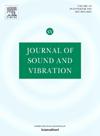实验模态分析中频响函数估计的不确定性
IF 4.3
2区 工程技术
Q1 ACOUSTICS
引用次数: 0
摘要
在实验模态分析中,频响函数的估计是基于输入和输出测量的,这容易由于噪声而产生不确定性。存在不同的估计器,如H1、H2等。使用哪个估计器完全取决于实验设置,因为在不同的设置中估计器具有不同的统计特性。本文给出了不同频响函数估计量H1、H2和Hv的实部和虚部的协方差表达式。协方差表达式是通过传播测量的不确定度得到的。在开发每个估计量的协方差表达式之前,简要介绍了从测量中识别不确定性的不同技术。对所考虑的估计量的这些协方差表达式进行了相同的结构,并提出了将不确定性从实部和虚部传播到幅度和相位的一般表达式。协方差表达式采用delta法,其中雅可比矩阵采用一阶摄动理论得到。通过简单的六自由度模拟质量-弹簧系统和蒙特卡罗仿真验证了表达式的正确性。验证表明,当测量不确定度被充分识别时,利用所开发的协方差表达式估计的不确定度与蒙特卡罗模拟的不确定度之间有很好的一致性。通过对一个类梁结构进行的激励和响应实验数据,说明了推导出的不确定性表达式的应用。本文章由计算机程序翻译,如有差异,请以英文原文为准。
Uncertainty in frequency response function estimates in experimental modal analysis
In experimental modal analysis, the estimation of frequency response functions is based on input and output measurements, which are prone to uncertainty due to noise. Different estimators exist, such as , , etc. Which estimator to use depends solely on the experimental setup, as the estimators have different statistical properties in different setups. This work presents covariance expressions for real and imaginary parts of different frequency response function estimators: , , and . The covariance expressions are obtained by propagating the uncertainty from measurements. Different techniques to identify the uncertainty from measurements are briefly presented before the covariance expressions for each estimator are developed. These covariance expressions for the considered estimators are structured identically, and a general expression to propagate the uncertainty from the real and imaginary parts to the amplitude and phase is developed and presented. The covariance expressions are developed using the Delta-method, where the Jacobians are obtained using first-order perturbation theory. The expressions are validated using a simple 6-DoF simulated mass–spring system and Monte-Carlo simulation. The validation shows good agreement between the estimated uncertainties using the developed covariance expressions and the uncertainties from the Monte-Carlo simulations when the measurement uncertainty is adequately identified. The application of the derived uncertainty expressions is illustrated using excitation and response data from an experiment conducted on a beam-like structure.
求助全文
通过发布文献求助,成功后即可免费获取论文全文。
去求助
来源期刊

Journal of Sound and Vibration
工程技术-工程:机械
CiteScore
9.10
自引率
10.60%
发文量
551
审稿时长
69 days
期刊介绍:
The Journal of Sound and Vibration (JSV) is an independent journal devoted to the prompt publication of original papers, both theoretical and experimental, that provide new information on any aspect of sound or vibration. There is an emphasis on fundamental work that has potential for practical application.
JSV was founded and operates on the premise that the subject of sound and vibration requires a journal that publishes papers of a high technical standard across the various subdisciplines, thus facilitating awareness of techniques and discoveries in one area that may be applicable in others.
 求助内容:
求助内容: 应助结果提醒方式:
应助结果提醒方式:


